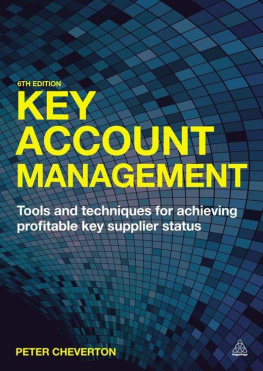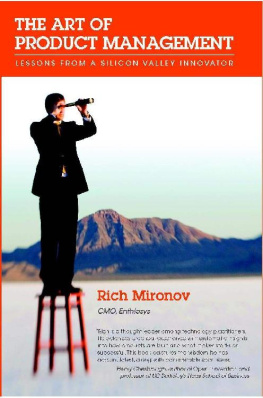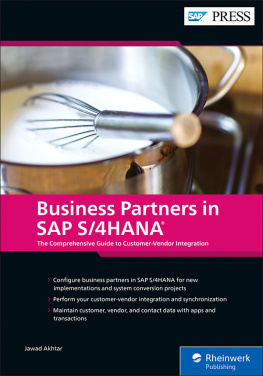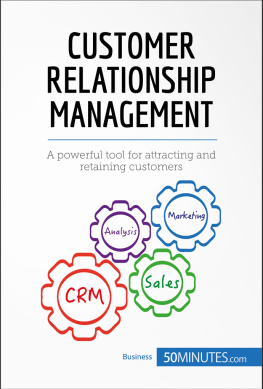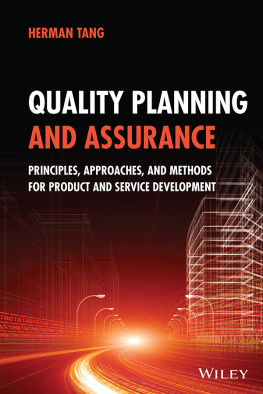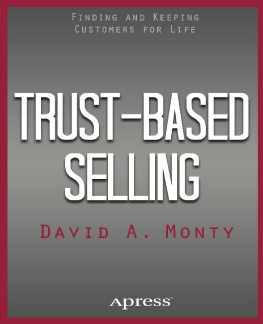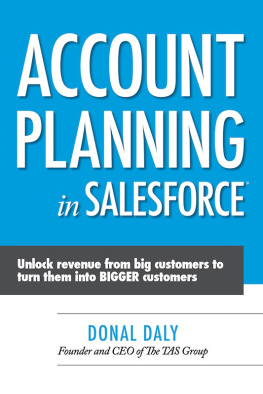
Note on the Ebook Edition For an optimal reading experience, please view large
tables and figures in landscape mode. |
This ebook published in 2015 by
Kogan Page Limited
2nd Floor, 45 Gee Street
London EC1V 3RS
UK
www.koganpage.com
Peter Cheverton, 1999, 2001, 2004, 2008, 2012, 2015
E-ISBN 978 0 7494 6941 2
Contents
For free online support material please go to the Kogan Page website: www.koganpage.com/KAM6 |
Peter Cheverton is a founding director of INSIGHT Marketing and People, a global training and consultancy firm specializing in Key and Global Key Account Management. He has developed an international reputation as one of the leading experts in this challenging area, working hands on with clients around the world, in industries as diverse as specialty chemicals, healthcare and pharmaceuticals, FMCG, retail, automotive, financial services, IT, packaging, and transport, helping them with the implementation of their tailored KAM strategies.
As well as working directly with clients in house, Peter regularly presents INSIGHTs Key Account Management Masterclass in cities around the world, including London, Aberdeen, Glasgow, Dublin, Paris, Brussels, Barcelona, Amsterdam, Stockholm, Gothenburg, Oslo, Vienna, Budapest, Prague, Bucharest, Warsaw, Shanghai, Beijing, Singapore, Kuala Lumpur, Seoul, Tokyo, Melbourne, Cape Town, Johannesburg, San Paulo, Boston, New York and Chicago.
He is also the author of Global Account Management, Key Account Management in Financial Services, Key Marketing Skills , The Value Machine, and Understanding the Professional Buyer , books used as standard texts by many international business schools.
Prior to establishing INSIGHT in 1991, Peter was the European sales and marketing manager for ICI Dulux Paints.
You can contact Peter at peter.cheverton@insight-mp.com
G ood books on Key Account Management are rare. One of the reasons for this lies in the past, in the way that Key Account Management (KAM) has been defined and described. The past 40 years have been characterized by a view that KAM is mainly a selling task, albeit at a high level, and that the responsibility for its implementation rests almost entirely with the sales team.
Yet all our research at Cranfield School of Management indicates that, above all else, it is this mentality that prevents the forging of mature, trustworthy and profitable relationships. Key Account Management is not a sales initiative, it is not something you do to customers, and key account strategies will require the full support of the business.
Key Account Management is a team effort and, more than that, it is a business-wide effort. Our research has shown repeatedly that major clients want more than a salesbuyer interface and they want more than a traditional salesperson managing the relationship. If suppliers and customers are to forge significant relationships, as businesses, then both sides must look to new ways of managing those relationships.
Relationships are at the very heart of KAM. They provide the source of information and understanding that can be built into added-value activities. They also provide the foundations for long-term business based on mutual trust and confidence. If you care about customer retention then you should care about KAM.
So lets escape the trap of the last 40 years KAM is not something we do to customers, it is something we do with customers, and perhaps the greatest single motivation for developing Key Account Strategies is that the customer is looking for new ways of working alongside key suppliers.
Purchasing organizations are looking more and more to the techniques of supply chain management as a means of prioritizing and managing relationships with significant suppliers. Those suppliers must respond with customer-sensitive strategies that will touch on everything from the people involved to the systems and processes used, and even to the structure and organization of the suppliers business.
Key Account Management provides the strategic base, the processes and the disciplines to handle this situation, alongside those other common challenges globalization, market maturity and customer power.
The purpose is clear: the pursuit of competitive advantage. The days are long gone when major customers would tolerate average, overpriced products and services. Being a pimply me too just wont work anymore.
Competitive advantage puts you in a position to succeed, but there is more that you need to do. There is the question of profit. Most companies, if they are honest, are not able to measure the profitability of their key accounts. Many companies, once they determine to measure these things, often find their largest customers to be their least profitable. Very few companies measure the long-term returns of customer retention annual results are often all that count. Key Account Management should be seen as the route to profitable key supplier status the challenge of understanding profit must be taken head on. This book will provide the help required.
Peter Cheverton has used the Cranfield research to great effect. I have worked closely with him for many years and have respect and admiration for his work as a trainer and consultant with major clients. The task of implementing Key Account Strategies is far from easy, and Peter brings a combination of clarity, experience, enthusiasm and common sense to the task. This book is an excellent distillation of his experience, building on the Cranfield research and producing the essential guide to global best practice.
Please be assured that reading this book will be a rewarding experience.
Professor Malcolm McDonald
Cranfield School of Management
T his book is designed as a practical guide to implementing Key Account Management (KAM) strategies. Wherever it has been helpful to do so, real examples of KAM practice have been used to illustrate important points. Many of these examples come from my own experience in working with the clients of INSIGHT Marketing and People, an international training and consultancy firm. Wherever possible the companies involved are openly discussed, but, for reasons that I hope are obvious, this is not always the case. In some of the more anonymous cases, details may have been altered slightly, either to aid clarity, or to protect the not so innocent!
I am pleased to be able to say that my training and consulting work brings me in contact with far more examples of good practice than bad, but the purpose of this book has not always permitted such a ratio. I hope that my own clients will forgive me for not filling these pages with more stories of their undoubted excellence in this field.
Please regard the examples of good practice, not as obligatory rules (there are very few of those in KAM), but as opportunities to compare and consider your own approach, and the examples of bad practice as warning signs posted along the road towards KAM excellence.
T he very fact that a sixth edition of this book is necessary tells us something about KAM: it is an evolving task, changing and adapting as new market and customer challenges appear.
One of the most significant of these challenges in recent times has been the development by purchasing professionals of Key Supplier Management strategies, often launched to pre-empt their suppliers ambitions to manage them . But what at first sight might look to be conflicting ambitions, turns out, if properly understood and skilfully handled, to be a route to genuine supplier/customer collaboration, one of the goals of this book.
Back in 1999 and the 1st edition, KAM was a new concept for many businesses. By now, it is well established as an approach to customer relationships, but the challenges of practical implementation remain, and indeed increase as its ambitions expand beyond those simple beginnings, and most particularly with regard to what we will call the internal challenges. This new edition takes then as its focus the issue of practical implementation and the task of making it happen, not just with the customer, but also within the suppliers own organisation.
Next page
